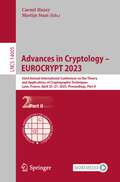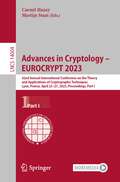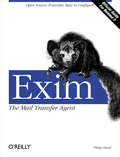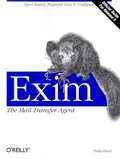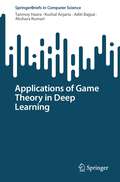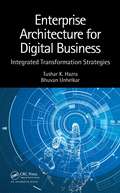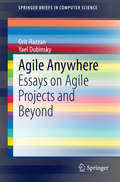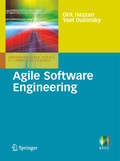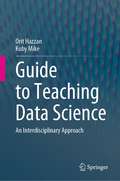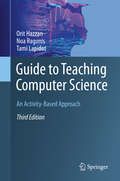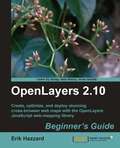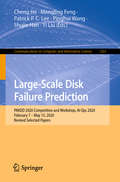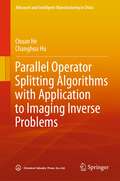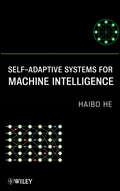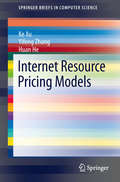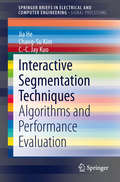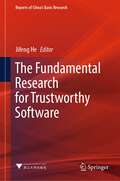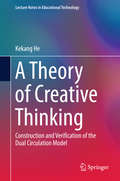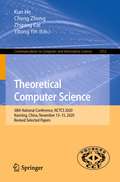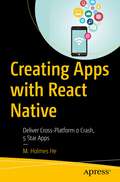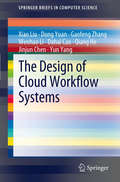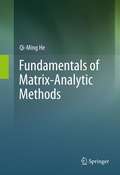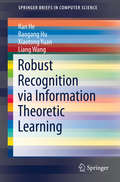- Table View
- List View
Advances in Cryptology – EUROCRYPT 2023: 42nd Annual International Conference on the Theory and Applications of Cryptographic Techniques, Lyon, France, April 23–27, 2023, Proceedings, Part II (Lecture Notes in Computer Science #14005)
by Carmit Hazay Martijn StamThis five-volume set, LNCS 14004 - 14008 constitutes the refereed proceedings of the 42nd Annual International Conference on Theory and Applications of Cryptographic Techniques, Eurocrypt 2023, which was held in Lyon, France, in April 2023.The total of 109 full papers presented were carefully selected from 415 submissions. They are organized in topical sections as follows: Theoretical Foundations; Public Key Primitives with Advanced Functionalities; Classic Public Key Cryptography; Secure and Efficient Implementation, Cryptographic Engineering, and Real-World Cryptography; Symmetric Cryptology; and finally Multi-Party Computation and Zero-Knowledge.
Advances in Cryptology – EUROCRYPT 2023: 42nd Annual International Conference on the Theory and Applications of Cryptographic Techniques, Lyon, France, April 23-27, 2023, Proceedings, Part I (Lecture Notes in Computer Science #14004)
by Carmit Hazay Martijn StamThis five-volume set, LNCS 14004 - 14008 constitutes the refereed proceedings of the 42nd Annual International Conference on Theory and Applications of Cryptographic Techniques, Eurocrypt 2023, which was held in Lyon, France, in April 2023.The total of 109 full papers presented were carefully selected from 415 submissions. They are organized in topical sections as follows: Theoretical Foundations; Public Key Primitives with Advanced Functionalities; Classic Public Key Cryptography; Secure and Efficient Implementation, Cryptographic Engineering, and Real-World Cryptography; Symmetric Cryptology; and finally Multi-Party Computation and Zero-Knowledge.
Exim: The Mail Transfer Agent
by Philip HazelExim delivers electronic mail, both local and remote. It has all the virtues of a good postman: it's easy to talk to, reliable, efficient, and eager to accommodate even the most complex special requests. It's the default mail transport agent installed on some Linux systems, runs on many versions of Unix, and is suitable for any TCP/IP network with any combination of hosts and end-user mail software. Exim is growing in popularity because it is open source, scalable, and rich in features such as the following: Compatibility with the calling interfaces and options of Sendmail (for which Exim is usually a drop-in replacement) Lookups in LDAP servers, MySQL and PostgreSQL databases, and NIS or NIS+ services Support for many kinds of address parsing, including regular expressions that are compatible with Perl 5 Sophisticated error handling Innumerable tuning parameters for improving performance and handling enormous volumes of mail Best of all, Exim is easy to configure. You never have to deal with ruleset 3 or worry that a misplaced asterisk will cause an inadvertent mail bomb. While a basic configuration is easy to read and can be created quickly, Exim's syntax and behavior do get more subtle as you enter complicated areas like virtual hosting, filtering, and automatic replies. This book is a comprehensive survey that provides quick information for people in a hurry as well as thorough coverage of more advanced material.
Exim
by Philip HazelExim is the default mail transport agent installed on some Linux systems; it runs on many versions of Unix and is suitable for any TCP/IP network with any combination of hosts and end-user mail software. It is open source, scalable, rich in features, and--best of all--easy to configure. This official guide is written by Philip Hazel, the creator of Exim.
The Fallacy of Net Neutrality
by Thomas W Hazlett"There is little dispute that the Internet should continue as an open platform," notes the U.S. Federal Communications Commission. Yet, in a curious twist of logic, the agency has moved to discontinue the legal regime successfully yielding that magnificent platform. In late 2010, it imposed "network neutrality" regulations on broadband access providers, both wired and wireless. Networks cannot (a) block subscribers' use of certain devices, applications, or services; (b) unreasonably discriminate, offering superior access for some services over others. The Commission argues that such rules are necessary, as the Internet was designed to bar "gatekeepers." The view is faulty, both in it engineering claims and its economic conclusions. Networks routinely manage traffic and often bundle content with data transport precisely because such coordination produces superior service. When "walled gardens" emerge, including AOL in 1995, Japan's DoCoMo iMode in 1999, or Apple's iPhone in 2007, they often disrupt old business models, thrilling consumers, providing golden opportunities for application developers, advancing Internet growth. In some cases these gardens have dropped their walls; others remain vibrant. The "open Internet" allows consumers, investors, and innovators to choose, discovering efficiencies. The FCC has mistaken that spontaneous market process for a planned market structure, imposing new rules to "protect" what evolved without them.
Applications of Game Theory in Deep Learning (SpringerBriefs in Computer Science)
by Tanmoy Hazra Kushal Anjaria Aditi Bajpai Akshara KumariThis book aims to unravel the complex tapestry that interweaves strategic decision-making models with the forefront of deep learning techniques. Applications of Game Theory in Deep Learning provides an extensive and insightful exploration of game theory in deep learning, diving deep into both the theoretical foundations and the real-world applications that showcase this intriguing intersection of fields. Starting with the essential foundations for comprehending both game theory and deep learning, delving into the individual significance of each field, the book culminates in a nuanced examination of Game Theory's pivotal role in augmenting and shaping the development of Deep Learning algorithms. By elucidating the theoretical underpinnings and practical applications of this synergistic relationship, we equip the reader with a comprehensive understanding of their combined potential. In our digital age, where algorithms and autonomous agents are becoming more common, the combination of game theory and deep learning has opened a new frontier of exploration. The combination of these two disciplines opens new and exciting avenues. We observe how artificial agents can think strategically, adapt to ever-shifting environments, and make decisions that are consistent with their goals and the dynamics of their surroundings. This book presents case studies, methodologies, and real-world applications.
Enterprise Architecture for Digital Business: Integrated Transformation Strategies
by Tushar K. Hazra Bhuvan UnhelkarEnterprise Architecture (EA) is an essential part of the fabric of a business; however, EA also transcends and transforms technology and moves it into the business space. Therefore, EA needs to be discussed in an integrated, holistic, and comprehensive manner. Only such an integrated approach to EA can provide the foundation for a transformation that readies the business for the myriad enterprise-wide challenges it will face. Highly disruptive technologies such as Big Data, Machine Learning, and Mobile and Cloud Computing require a fine balance between their business and technical aspects as an organization moves forward with its digital transformation. This book focuses on preparing all organizations – large and small – and those wishing to move into them for the impact of leveraging these emerging, disruptive, and innovative technologies within the EA framework.
Agile Anywhere: Essays on Agile Projects and Beyond (SpringerBriefs in Computer Science)
by Orit Hazzan Yael DubinskyThe message conveyed in this work is that agility can be implemented anywhere. Accordingly, ten guidelines are presented for the adoption of agility to enable us to cope with changes in our lives, in our teams, and in our organizations. Since the authors advocate agility, the content is presented in the form of concise standalone chapters, allowing the reader to focus on the specific topic they wish to adopt in order to become agile.
Agile Software Engineering: 12th International Conference, Xp 2011, Madrid, Spain, May 10-13, 2011, Proceedings (Undergraduate Topics in Computer Science #77)
by Orit Hazzan Yael DubinskyThis textbook presents the current issues in software development methods. Special emphasis is placed on agile software development, being one of the mainstream paradigms for the management of software projects. Features and topics: (1) Examines the Agile manifesto and its implications. (2) Discusses the delivery of software projects on time and within budgets by using agile software development environment. (3) Considers the customer role in agile software development environments. (4) Looks at measures to control and monitor the software development process. (5) Offers Agile software development processes from a cognitive perspective. (6) Explores the concept of agility from the management perspective. (7) Investigates the impact of agility on the organization level. (8) The wider context of each topic to software engineering is emphasized. This comprehensive and concise introduction offers a reader-friendly approach to the topic. Written for advanced undergraduates, this clear foundation course will also be valuable for practitioners.
Guide to Teaching Data Science: An Interdisciplinary Approach
by Orit Hazzan Koby MikeData science is a new field that touches on almost every domain of our lives, and thus it is taught in a variety of environments. Accordingly, the book is suitable for teachers and lecturers in all educational frameworks: K-12, academia and industry.This book aims at closing a significant gap in the literature on the pedagogy of data science. While there are many articles and white papers dealing with the curriculum of data science (i.e., what to teach?), the pedagogical aspect of the field (i.e., how to teach?) is almost neglected. At the same time, the importance of the pedagogical aspects of data science increases as more and more programs are currently open to a variety of people.This book provides a variety of pedagogical discussions and specific teaching methods and frameworks, as well as includes exercises, and guidelines related to many data science concepts (e.g., data thinking and the data science workflow), main machine learning algorithms and concepts (e.g., KNN, SVM, Neural Networks, performance metrics, confusion matrix, and biases) and data science professional topics (e.g., ethics, skills and research approach).Professor Orit Hazzan is a faculty member at the Technion’s Department of Education in Science and Technology since October 2000. Her research focuses on computer science, software engineering and data science education. Within this framework, she studies the cognitive and social processes on the individual, the team and the organization levels, in all kinds of organizations.Dr. Koby Mike is a Ph.D. graduate from the Technion's Department of Education in Science and Technology under the supervision of Professor Orit Hazzan. He continued his post-doc research on data science education at the Bar-Ilan University, and obtained a B.Sc. and an M.Sc. in Electrical Engineering from Tel Aviv University.
Guide to Teaching Computer Science: An Activity-Based Approach
by Orit Hazzan Noa Ragonis Tami LapidotThis concise yet thorough textbook presents an active-learning model for the teaching of computer science. Offering both a conceptual framework and detailed implementation guidelines, the work is designed to support a Methods of Teaching Computer Science (MTCS) course, but may be applied to the teaching of any area of computer science at any level, from elementary school to university. This text is not limited to any specific curriculum or programming language, but instead suggests various options for lesson and syllabus organization.Fully updated and revised, the third edition features more than 40 new activities, bringing the total to more than 150, together with new chapters on computational thinking, data science, and soft concepts and soft skills. This edition also introduces new conceptual frameworks for teaching such as the MERge model, and new formats for the professional development of computer science educators.Topics and features: includes an extensive set of activities, to further support the pedagogical principles outlined in each chapter; discusses educational approaches to computational thinking, how to address soft concepts and skills in a MTCS course, and the pedagogy of data science (NEW); focuses on teaching methods, lab-based teaching, and research in computer science education, as well as on problem-solving strategies; examines how to recognize and address learners’ misconceptions, and the different types of questions teachers can use to vary their teaching methods; provides coverage of assessment, teaching planning, and designing a MTCS course; reviews high school teacher preparation programs, and how prospective teachers can gain experience in teaching computer science.This easy-to-follow textbook and teaching guide will prove invaluable to computer science educators within all frameworks, including university instructors and high school teachers, as well as to instructors of computer science teacher preparation programs.
OpenLayers 2.10 Beginner's Guide
by Erik HazzardThis is a beginner's guide with the essential screenshots and clearly explained code, which also serves as a reference.This book is for anyone who has any interest in using maps on their website, from hobbyists to professional web developers. OpenLayers provides a powerful, but easy-to-use, pure JavaScript and HTML (no third-party plug-ins involved) toolkit to quickly make cross-browser web maps. A basic understanding of JavaScript will be helpful, but there is no prior knowledge required to use this book. If you've never worked with maps before, this book will introduce you to some common mapping topics and gently guide you through the OpenLayers library. If you're an experienced application developer, this book will also serve as a reference to the core components of OpenLayers.
Large-Scale Disk Failure Prediction: PAKDD 2020 Competition and Workshop, AI Ops 2020, February 7 – May 15, 2020, Revised Selected Papers (Communications in Computer and Information Science #1261)
by Cheng He Mengling Feng Patrick P. C. Lee Pinghui Wang Shujie Han Yi LiuThis book constitutes the thoroughly refereed post-competition proceedings of the AI Ops Competition on Large-Scale Disk Failure Prediction, conducted between February 7th and May 15, 2020 on the Alibaba Cloud Tianchi Platform. A dedicated workshop, featuring the best performing teams of the competition, was held at the 24th Pacific-Asia Conference on Knowledge Discovery and Data Mining, PAKDD 2020, in Singapore, in April 2019. Due to the COVID-19 pandemic, the workshop was hosted online. This book includes 13 selected contributions: an introduction to dataset, selected approaches of the competing teams and the competition summary, describing the competition task, practical challenges, evaluation metrics, etc.
Parallel Operator Splitting Algorithms with Application to Imaging Inverse Problems (Advanced and Intelligent Manufacturing in China)
by Chuan He Changhua HuImage denoising, image deblurring, image inpainting, super-resolution, and compressed sensing reconstruction have important application value in engineering practice, and they are also the hot frontiers in the field of image processing. This book focuses on the numerical analysis of ill condition of imaging inverse problems and the methods of solving imaging inverse problems based on operator splitting. Both algorithmic theory and numerical experiments have been addressed. The book is divided into six chapters, including preparatory knowledge, ill-condition numerical analysis and regularization method of imaging inverse problems, adaptive regularization parameter estimation, and parallel solution methods of imaging inverse problem based on operator splitting. Although the research methods in this book take image denoising, deblurring, inpainting, and compressed sensing reconstruction as examples, they can also be extended to image processing problems such as image segmentation, hyperspectral decomposition, and image compression. This book can benefit teachers and graduate students in colleges and universities, or be used as a reference for self-study or further study of image processing technology engineers.
Self-Adaptive Systems for Machine Intelligence
by Haibo HeThis book will advance the understanding and application of self-adaptive intelligent systems; therefore it will potentially benefit the long-term goal of replicating certain levels of brain-like intelligence in complex and networked engineering systems. It will provide new approaches for adaptive systems within uncertain environments. This will provide an opportunity to evaluate the strengths and weaknesses of the current state-of-the-art of knowledge, give rise to new research directions, and educate future professionals in this domain.Self-adaptive intelligent systems have wide applications from military security systems to civilian daily life. In this book, different application problems, including pattern recognition, classification, image recovery, and sequence learning, will be presented to show the capability of the proposed systems in learning, memory, and prediction. Therefore, this book will also provide potential new solutions to many real-world applications.
Waveform Design for Active Sensing Systems
by Hao He Jian Li Petre StoicaWith a focus on developing computational algorithms for examining waveform design in diverse active sensing applications, this guide is ideal for researchers and practitioners in the field. The three parts conveniently correspond to the three categories of desirable waveform properties: good aperiodic correlations, good periodic correlations and beampattern matching. The book features various application examples of using the newly designed waveforms, including radar imaging, channel estimation for communications, an ultrasound system for breast cancer treatment and covert underwater communications. In addition to numerical results, the authors present theoretical analyses describing lower bounds or limitations of performance. Focusing on formulating practical problems mathematically and solving the mathematical problems using efficient and effective optimization techniques, the text pays particular attention to developing easy-to-use computational approaches. Most algorithms are accompanied by a table clearly detailing iteration steps and corresponding MATLAB codes are available on the companion website.
Internet Resource Pricing Models
by Huan He Yifeng Zhong Ke XuThis brief guides the reader through three basic Internet resource pricing models using an Internet cost analysis. Addressing the evolution of service types, it presents several corresponding mechanisms which can ensure pricing implementation and resource allocation. The authors discuss utility optimization of network pricing methods in economics and underline two classes of pricing methods including system optimization and entities' strategic optimization. The brief closes with two examples of the newly proposed pricing strategy helping to solve the profit distribution problem brought by P2P free-riding and improve the pricing efficiency with the introduction of the price discrimination. The Internet resource pricing strategy is not only the key factor of Internet resource allocation efficiency, but also the determinant of the profit. The methods and models discussed in Internet Resource Pricing Models increase the efficiency of existing pricing strategies to ensure a sound and sustainable development of the Internet. The brief will help researchers and professionals working with this key factor of Internet resource allocation.
Interactive Segmentation Techniques: Algorithms and Performance Evaluation
by Jia He C.-C. Jay Kuo Chang-Su KimThis book focuses on interactive segmentation techniques, which have been extensively studied in recent decades. Interactive segmentation emphasizes clear extraction of objects of interest, whose locations are roughly indicated by human interactions based on high level perception. This book will first introduce classic graph-cut segmentation algorithms and then discuss state-of-the-art techniques, including graph matching methods, region merging and label propagation, clustering methods, and segmentation methods based on edge detection. A comparative analysis of these methods will be provided with quantitative and qualitative performance evaluation, which will be illustrated using natural and synthetic images. Also, extensive statistical performance comparisons will be made. Pros and cons of these interactive segmentation methods will be pointed out, and their applications will be discussed. There have been only a few surveys on interactive segmentation techniques, and those surveys do not cover recent state-of-the art techniques. By providing comprehensive up-to-date survey on the fast developing topic and the performance evaluation, this book can help readers learn interactive segmentation techniques quickly and thoroughly.
The Fundamental Research for Trustworthy Software (Reports of China’s Basic Research)
by Jifeng HeThis book mainly introduces the research overview, results, and achievements of “The Fundamental Research for Trustworthy Software”, a major research plan of NSFC. The Plan focuses on four key scientific issues:(i) measurement and modeling of software trustworthiness;(ii) construction and verification of trustworthy software;(iii) evolution and control of trustworthy software;(iv) trusted environment construction and evaluation.This book aims to establish a research framework for fundamental research on trustworthy software by focusing on the trustworthiness of embedded software and network application software, as well as the trustworthiness of software in key application fields in China. This book is intended for researchers who have been following the evolution of and trends in the trustworthy software; the book is also a valuable reference resource for practitioners and scholars at various levels and in various fields.
A Theory of Creative Thinking: Construction and Verification of the Dual Circulation Model (Lecture Notes in Educational Technology)
by Kekang HeThis book examines research on creative thinking, both current and historical. It explores two dimensions of human thought (time and space) and two modes of thinking (conscious and unconscious) as well as both left and right brain functions and artistic and scientific creative activities. The book proposes a "Double Circulation" model of creative thinking and argues that imagery thinking, intuitive thinking and logical thinking are main parts of creative thinking and that dialectical thinking and horizontal-vertical thinking are the guides for highly complex problem-solving thoughts and strategies. The book focuses on education and psychology and also covers how to use ICT to promote students' creative thinking skills. Researchers will benefit from the "Double Circulation" model, which provides a new perspective on conducting creative thinking research. The book is also a valuable resource for graduate students in the fields of educational technology and psychology and for all readers who are interested in creative thinking.
Theoretical Computer Science: 38th National Conference, NCTCS 2020, Nanning, China, November 13–15, 2020, Revised Selected Papers (Communications in Computer and Information Science #1352)
by Kun He Cheng Zhong Zhiping Cai Yitong YinThis book constitutes the thoroughly refereed proceedings of the 38th National Conference of Theoretical Computer Science, NCTCS 2020, held in Nanning, China, in November 2020. The 13 full papers presented were carefully reviewed and selected from 28 submissions. They present recent research in the areas of algorithms and complexity, matrix computation; deep learning; network communication and security.
Creating Apps with React Native: Deliver Cross-Platform 0 Crash, 5 Star Apps
by M. Holmes HeProduce high-quality, cross-platform apps with user experiences almost identical to pure native apps. When evaluating cross-platform frameworks, developers make an assumption that quality will be compromised. But that doesn't have to be true. The principles in this book will show you how to meet quality expectations both from engineering and consumer standpoints. You’ll also realize the ideal of a greater front end. That means your whole front-end team, including app side and web side, will be optimized. The shared knowledge base as well as mobilization potential give more flexibility and strength in all front-end facets without the need of increasing team sizes.The market has seen a large amount of high quality React Native apps and successful stories about them. Nevertheless, under optimized apps and unsuccessful stories shadow. The fundamental difference between the two opposing groups is understanding. Discover the critical points in the React and React Native architecture, and develop general best practices that can lead to consistently developing 0 crash, 5 star apps based on an understanding of fundamentals.What You'll LearnMeasure and define successful app designCreate animation based on user needReduce performance bottleneck throughout your appsWho This Book Is ForMobile developers who want to expand their front end skill set, and web developers who want to enter mobile development.
The Design of Cloud Workflow Systems
by Qiang He Dahai Cao Dong Yuan Wenhao Li Xiao Liu Yun Yang Gaofeng Zhang Jinjun ChenCloud computing is the latest market-oriented computing paradigm which brings software design and development into a new era characterized by "XaaS", i.e. everything as a service. Cloud workflows, as typical software applications in the cloud, are composed of a set of partially ordered cloud software services to achieve specific goals. However, due to the low QoS (quality of service) nature of the cloud environment, the design of workflow systems in the cloud becomes a challenging issue for the delivery of high quality cloud workflow applications. To address such an issue, this book presents a systematic investigation to the three critical aspects for the design of a cloud workflow system, viz. system architecture, system functionality and quality of service. Specifically, the system architecture for a cloud workflow system is designed based on the general four-layer cloud architecture, viz. application layer, platform layer, unified resources layer and fabric layer. The system functionality for a cloud workflow system is designed based on the general workflow reference model but with significant extensions to accommodate software services in the cloud. The support of QoS is critical for the quality of cloud workflow applications. This book presents a generic framework to facilitate a unified design and development process for software components that deliver lifecycle support for different QoS requirements. While the general QoS requirements for cloud workflow applications can have many dimensions, this book mainly focuses on three of the most important ones, viz. performance, reliability and security. In this book, the architecture, functionality and QoS management of our SwinDeW-C prototype cloud workflow system are demonstrated in detail as a case study to evaluate our generic design for cloud workflow systems. To conclude, this book offers a general overview of cloud workflow systems and provides comprehensive introductions to the design of the system architecture, system functionality and QoS management.
Fundamentals of Matrix-Analytic Methods
by Qi-Ming HeFundamentals of Matrix-Analytic Methods targets advanced-level students in mathematics, engineering and computer science. It focuses on the fundamental parts of Matrix-Analytic Methods, Phase-Type Distributions, Markovian arrival processes and Structured Markov chains and matrix geometric solutions. New materials and techniques are presented for the first time in research and engineering design. This book emphasizes stochastic modeling by offering probabilistic interpretation and constructive proofs for Matrix-Analytic Methods. Such an approach is especially useful for engineering analysis and design. Exercises and examples are provided throughout the book.
Robust Recognition via Information Theoretic Learning
by Ran He Baogang Hu Xiaotong Yuan Liang WangThis Springer Brief represents a comprehensive review of information theoretic methods for robust recognition. A variety of information theoretic methods have been proffered in the past decade, in a large variety of computer vision applications; this work brings them together, attempts to impart the theory, optimization and usage of information entropy. The authors resort to a new information theoretic concept, correntropy, as a robust measure and apply it to solve robust face recognition and object recognition problems. For computational efficiency, the brief introduces the additive and multiplicative forms of half-quadratic optimization to efficiently minimize entropy problems and a two-stage sparse presentation framework for large scale recognition problems. It also describes the strengths and deficiencies of different robust measures in solving robust recognition problems.
